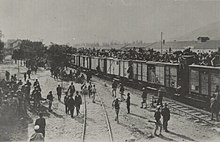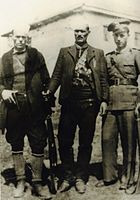
Pomaks are Bulgarian-speaking Muslims inhabiting Bulgaria, northwestern Turkey, and northeastern Greece. The c. 220,000 strong ethno-confessional minority in Bulgaria is recognized officially as Bulgarian Muslims by the government. The term has also been used as a wider designation, including also the Slavic Muslim populations of North Macedonia and Albania.

Greater Albania is an irredentist and nationalist concept that seeks to unify the lands that many Albanians consider to form their national homeland. It is based on claims on the present-day or historical presence of Albanian populations in those areas. In addition to the existing Albania, the term incorporates claims to regions in the neighbouring states, the areas include Kosovo, the Preševo Valley of Serbia, territories in southern Montenegro, northwestern Greece, and a western part of North Macedonia.

The region of Macedonia is known to have been inhabited since Paleolithic times.

The Torbeši are a Macedonian-speaking Muslim ethnoreligious group in North Macedonia and Albania. The Torbeši are also referred to as Macedonian Muslims or Muslim Macedonians. They have been culturally distinct from the Orthodox Christian Macedonian community for centuries, and are linguistically distinct from the larger Muslim ethnic groups in the greater region of Macedonia: the Albanians, Turks and Romanis. However, some Torbeši also still maintain a strong affiliation with Turkish identity and with Macedonian Turks. The regions inhabited by these Macedonian-speaking Muslims are Debarska Župa, Dolni Drimkol, Reka, and Golo Brdo.
Serbianisation or Serbianization, also known as Serbification, and Serbisation or Serbization is the spread of Serbian culture, people, and language, either by social integration or by cultural or forced assimilation.
Albanisation, Albanianisation (UK), Albanization, or Albanianization (US) is the spread of Albanian culture, people, and language, either by integration or assimilation. Diverse peoples were affected by Albanisation including peoples with different ethnic origins, such as Turks, Serbs, Croats, Circassians, Bosniaks, Greeks, Aromanians, Ashkali and Balkan Egyptians, Romani, Gorani, and Macedonians from all the regions of the Balkans.
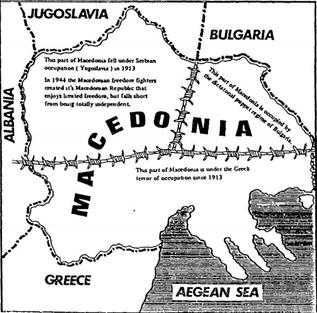
United Macedonia, or Greater Macedonia, is an irredentist concept among Macedonian nationalists that aims to unify the transnational region of Macedonia in Southeastern Europe into a single state that would be dominated by ethnic Macedonians. The proposed capital of such a United Macedonia is the city of Thessaloniki, the capital of Greek Macedonia, which ethnic Macedonians and the Yugoslav leader Josip Broz Tito had planned to incorporate into their own states.

Serbian nationalism asserts that Serbs are a nation and promotes the cultural and political unity of Serbs. It is an ethnic nationalism, originally arising in the context of the general rise of nationalism in the Balkans under Ottoman rule, under the influence of Serbian linguist Vuk Stefanović Karadžić and Serbian statesman Ilija Garašanin. Serbian nationalism was an important factor during the Balkan Wars which contributed to the decline of the Ottoman Empire, during and after World War I when it contributed to the dissolution of the Austro-Hungarian Empire, and again during the breakup of Yugoslavia and the Yugoslav Wars of the 1990s.

Islam in Kosovo has a long-standing tradition dating back to the Ottoman conquest of the Balkans. Before the Battle of Kosovo in 1389, the entire Balkan region had been Christianized by both the Western and Eastern Roman Empire. From 1389 until 1912, Kosovo was officially governed by the Muslim Ottoman Empire and a high level of Islamization occurred among Catholic and Orthodox Albanians, mainly due to Sufi orders and socio-political opportunism. Both Christian and Muslim Albanians intermarried and some lived as "Laramans", also known as Crypto-Christians. During the time period after World War II, Kosovo was ruled by secular socialist authorities in the Socialist Federal Republic of Yugoslavia (SFRY). During that period, Kosovars became increasingly secularized. After the end of Communist period religion had a revival in Kosovo. Today, 95.6% of Kosovo's population are Muslims, most of whom are ethnic Albanians. There are also non-Albanian speaking Muslims, who define themselves as Bosniaks, Gorani and Turks.
Albanian nationalism is a general grouping of nationalist ideas and concepts generated by ethnic Albanians that were first formed in the 19th century during the Albanian National Awakening. Albanian nationalism is also associated with similar concepts, such as Albanianism ("Shqiptaria") and Pan-Albanianism, that includes ideas on the creation of a geographically expanded Albanian state or a Greater Albania encompassing adjacent Balkan lands with substantial Albanian populations.
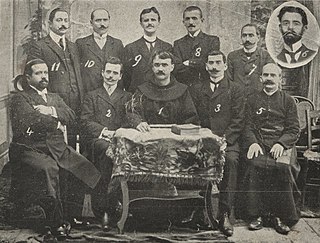
The Congress of Manastir was an academic conference held in the city of Manastir from November 14 to 22, 1908, with the goal of standardizing the Albanian alphabet. November 22 is now a commemorative day in Albania, Kosovo and North Macedonia, as well as among the Albanian diaspora, known as Alphabet Day. Prior to the Congress, the Albanian language was represented by a combination of six or more distinct alphabets, plus a number of sub-variants.

Macedonians or Macedonian Bulgarians, sometimes also referred to as Macedono-Bulgarians, Macedo-Bulgarians, or Bulgaro-Macedonians are a regional, ethnographic group of ethnic Bulgarians, inhabiting or originating from the region of Macedonia. Today, the larger part of this population is concentrated in Blagoevgrad Province but much is spread across the whole of Bulgaria and the diaspora.
Turco-Albanian is an ethnographic, religious, and derogatory term used by Greeks for Muslim Albanians from 1715 and thereafter. In a broader sense, the term included both Muslim Albanian and Turkish political and military elites of the Ottoman administration in the Balkans. The term is derived from an identification of Muslims with Ottomans and/or Turks, due to the Ottoman Empire's administrative millet system of classifying peoples according to religion, where the Muslim millet played the leading role. From the middle of the nineteenth century, the term Turk and from the late nineteenth century onwards, the derivative term Turco-Albanian has been used as a pejorative term, phrase and or expression for Muslim Albanian individuals and communities. The term has also been noted to be unclear, ideologically and sentimentally charged, and an imperialist and racialist expression. Albanians have expressed derision and disassociation toward the terms Turk and its derivative form Turco-Albanian regarding the usage of those terms in reference to them. It has been reported that at the end of the 20th century some Christian Albanians still used the term "Turk" to refer to Muslim Albanians.
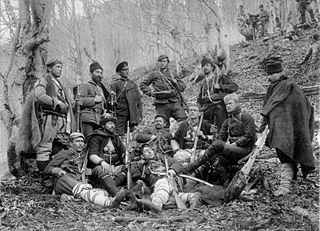
A cheta, in plural chetas, were irregular armed bands present throughout 19th century Ottoman Empire, particularly Anatolia and the Balkans. The members of the chetas were called chetniks.
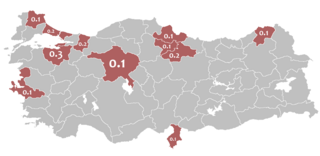
Albanians in Turkey are ethnic Albanian citizens and denizens of Turkey. They consist of Albanians who arrived during the Ottoman period, Kosovar/Macedonian and Tosk Cham Albanians fleeing from Serbian and Greek persecution after the beginning of the Balkan Wars, alongside some Albanians from Montenegro and Albania proper. A 2008 report from the Turkish National Security Council (MGK) estimated that approximately 1.3 million people of Albanian ancestry live in Turkey, and more than 500,000 recognizing their ancestry, language and culture. There are other estimates however that place the number of people in Turkey with Albanian ancestry and background upward to 5 or 6 million.
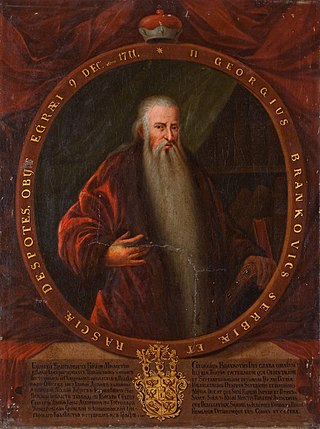
Serbian historiography refers to the historiography of the Serb people since the founding of Serbian statehood. The development can be divided into four main stages: traditional historiography, Ruvarac's critical school, Communist–Marxist legacy, and the renewed Serbian national movement.
The Islamization of Albania occurred as a result of the Ottoman conquest of the region beginning in 1385. The Ottomans through their administration and military brought Islam to Albania through various policies and tax incentives, trade networks and transnational religious links. In the first few centuries of Ottoman rule, the spread of Islam in Albania was slow and mainly intensified during the seventeenth and eighteenth centuries due in part to greater Ottoman societal and military integration, geo-political factors and collapse of church structures. It was one of the most significant developments in Albanian history as Albanians in Albania went from being a largely Christian population to one that is mainly Sunni Muslim, while retaining significant ethnic Albanian Christian minorities in certain regions. The resulting situation where Sunni Islam was the largest faith in the Albanian ethnolinguistic area, but other faiths were also present in a regional patchwork, played a major influence in shaping the political development of Albania in the late Ottoman period. Apart from religious changes, conversion to Islam also brought about other social and cultural transformations that have shaped and influenced Albanians and Albanian culture.

Islam in Albania (1800–1912) refers to the period that followed on after the conversion to Islam by a majority of Albanians in the 17th and 18th centuries. By the beginning of 19th century Islam had become consolidated within Albania and little conversion occurred. With the Eastern Crisis of the 1870s and its geo-political implications of partition for Albanians, the emerging National Awakening became a focal point of reflection and questioned the relationship between Muslim Albanians, Islam and the Ottoman Empire. These events and other changing social dynamics revolving around Islam would come to influence how Albanians viewed the Muslim faith and their relationship to it. Those experiences and views carried on in the 20th century had profound implications on shaping Islam in Albania that surfaced during the communist era.
Kosovo is the birthplace of the Albanian nationalist movement which emerged as a response to the Eastern Crisis of 1878. In the immediate aftermath of the Russo-Ottoman war, the Congress of Berlin proposed partitioning Ottoman Albanian inhabited lands in the Balkans among neighbouring countries. The League of Prizren was formed by Albanians to resist those impositions. For Albanians those events have made Kosovo an important place regarding the emergence of Albanian nationalism. During the remainder of the late Ottoman period various disagreements between Albanian nationalists and the Ottoman Empire over socio-cultural rights culminated in two revolts within Kosovo and adjacent areas. The Balkan Wars (1912–13) ending with Ottoman defeat, Serbian and later Yugoslav sovereignty over the area generated an Albanian nationalism that has become distinct to Kosovo stressing Albanian language, culture, and identity within the context of secession from Serbia. Pan-Albanian sentiments are also present and historically have been achieved only once when part of Kosovo was united by Italian Axis forces to their protectorate of Albania during the Second World War.
Albanian nationalism emerged in Albania during the 19th century. By the late Ottoman period Albanians were mainly Muslims with close ties to the Ottoman Empire. The lack of previous Albanian statehood to draw upon resulted in Albanian nationalism developing later unlike neighbouring nationalisms of the Serbs and Greeks. The onset of the Eastern crisis (1870s) that threatened partition of Balkan Albanian inhabited lands by neighbouring Orthodox Christian states stimulated the emergence of the Albanian national awakening (Rilindja) and nationalist movement. During the 19th century, some Western scholarly influences, Albanian diasporas such as the Arbereshë and Albanian National Awakening figures contributed greatly to spreading influences and ideas among Balkan Albanians within the context of Albanian self-determination. Among those were ideas of an Illyrian contribution to Albanian ethnogenesis which still dominate Albanian nationalism in contemporary times and other ancient peoples claimed as ancestors of the Albanians, in particular the Pelasgians of which have been claimed again in recent times.


